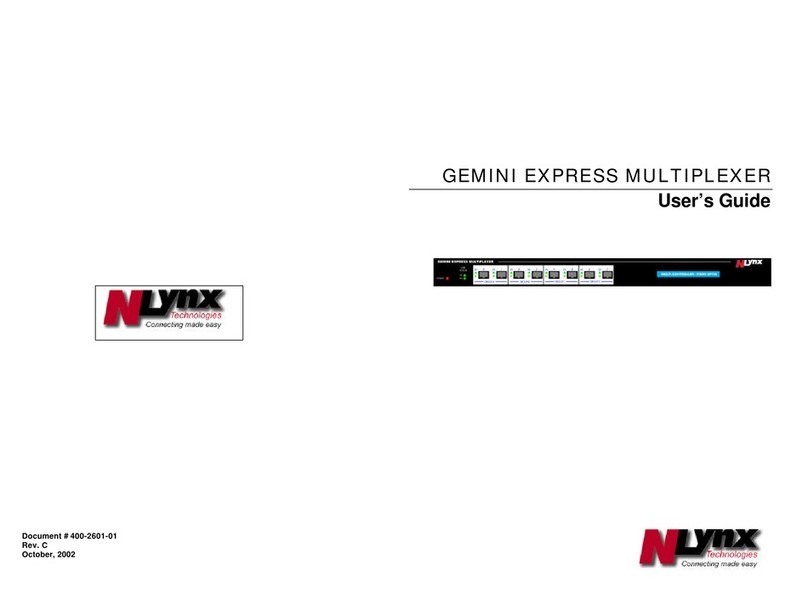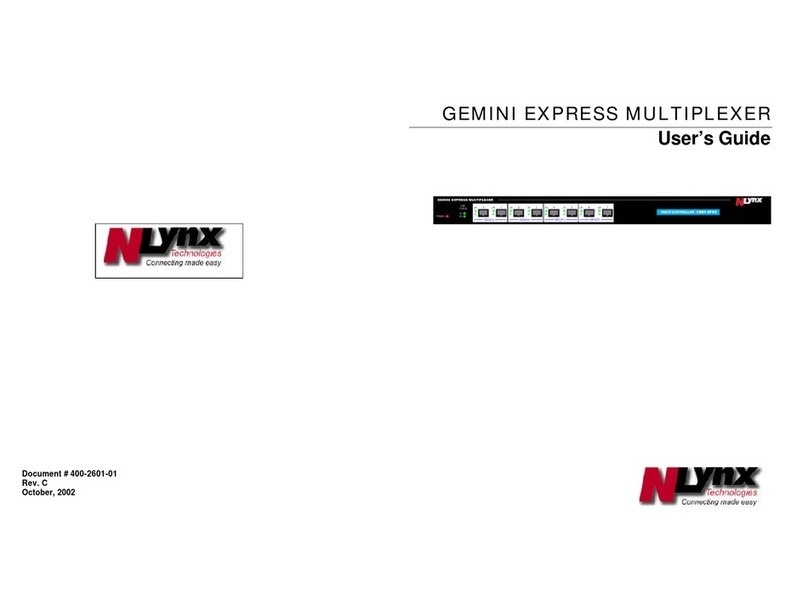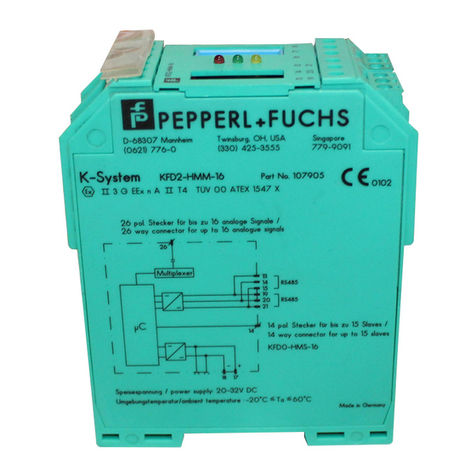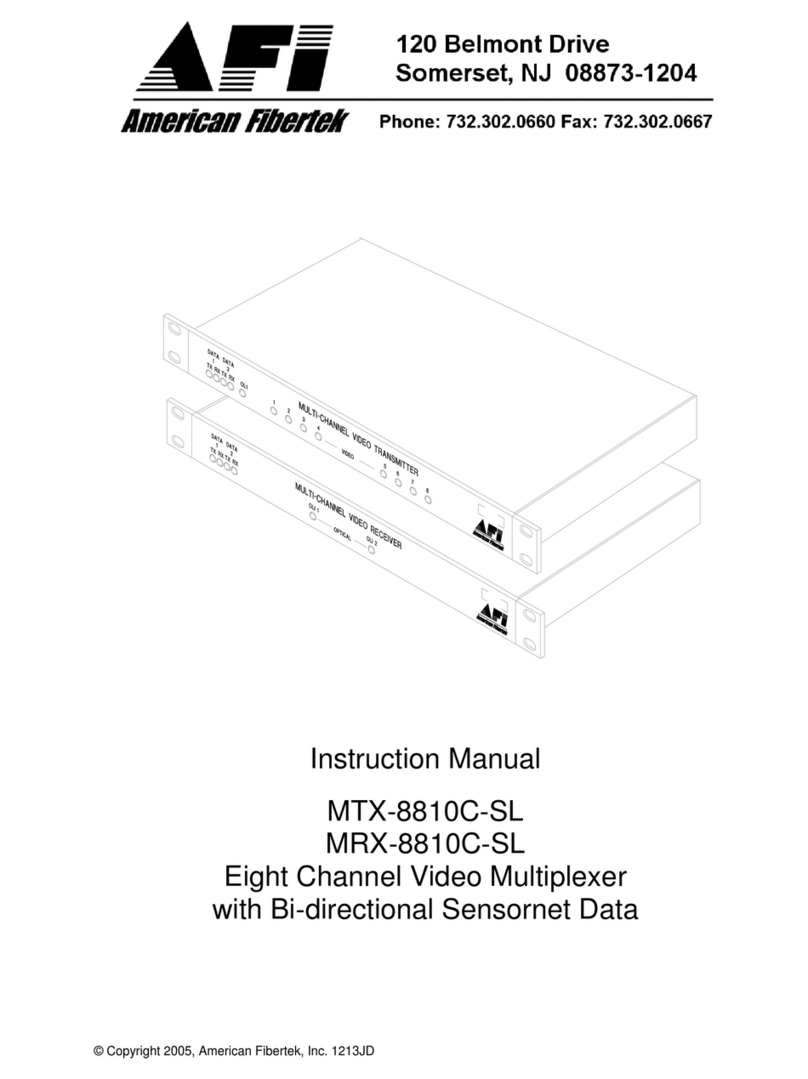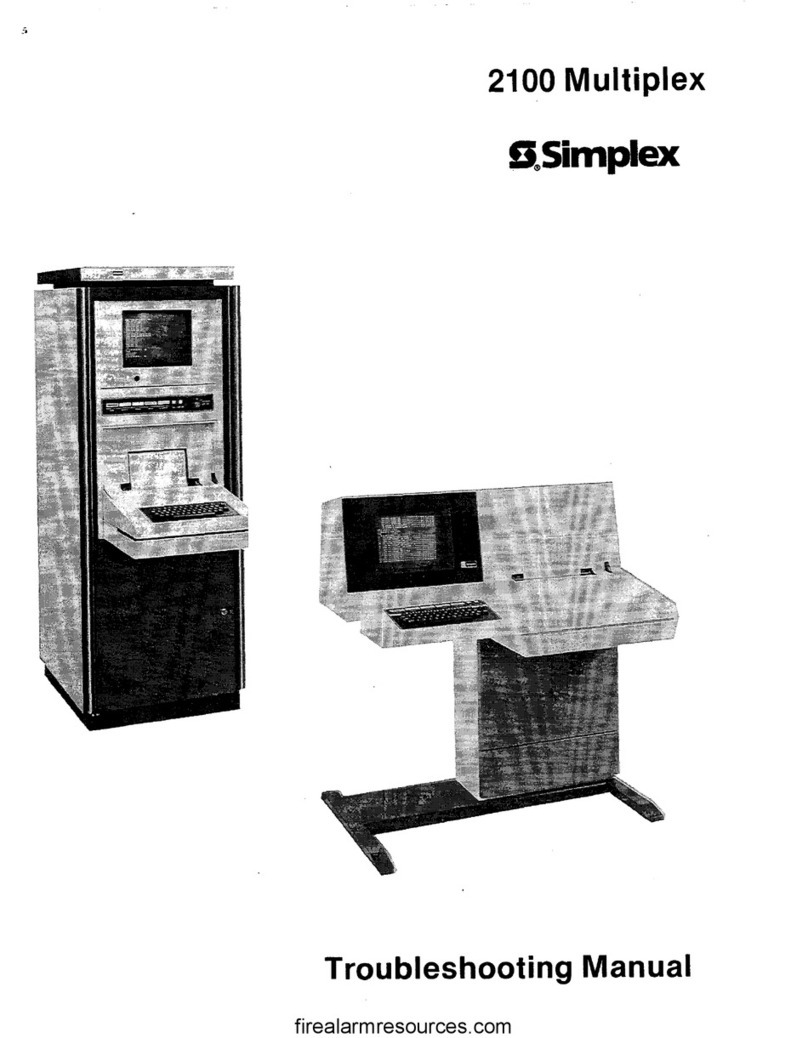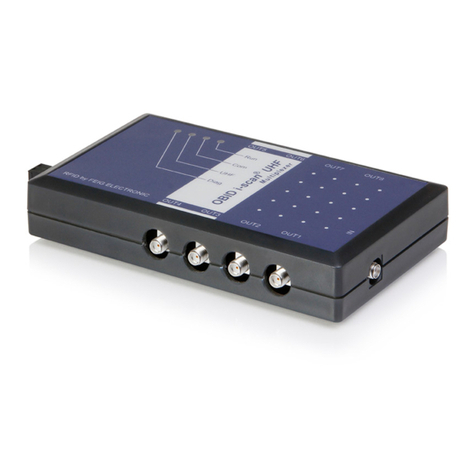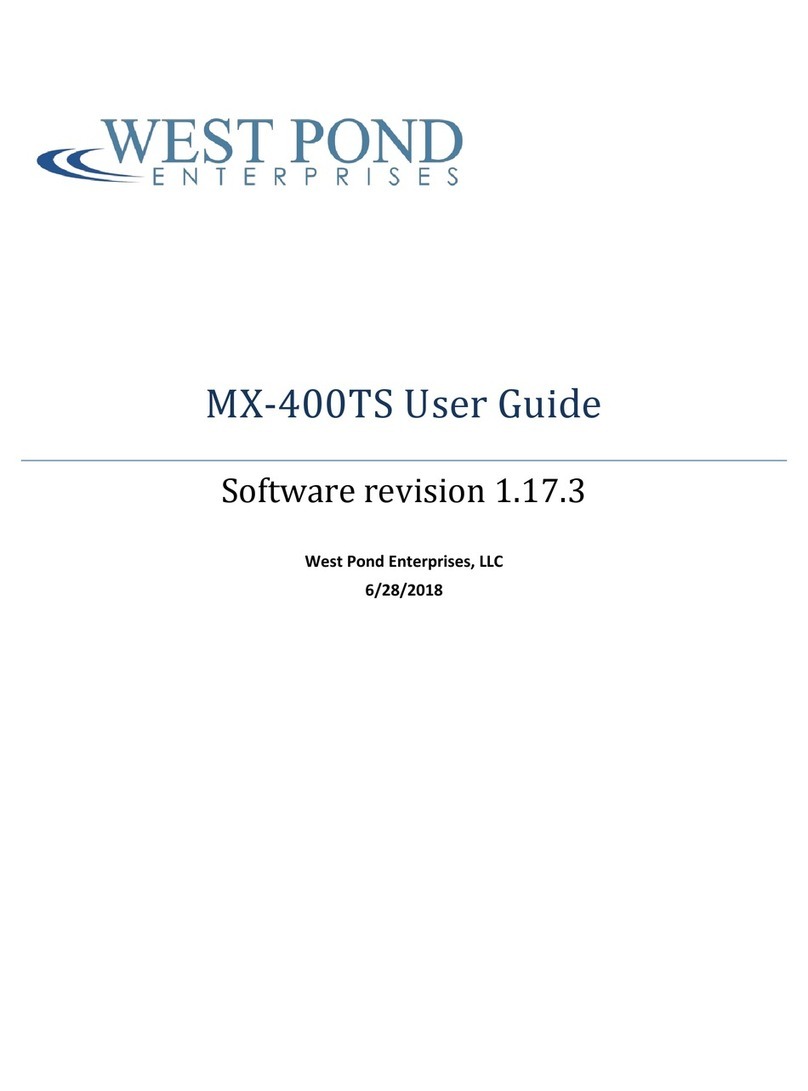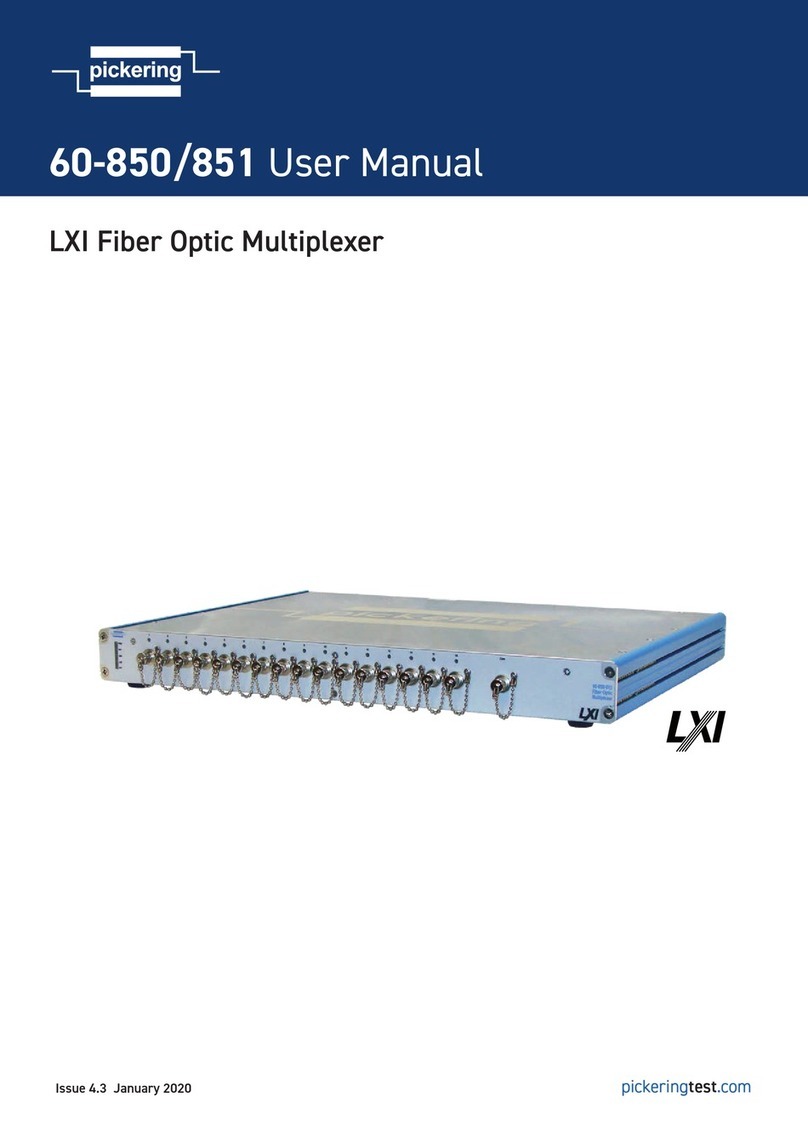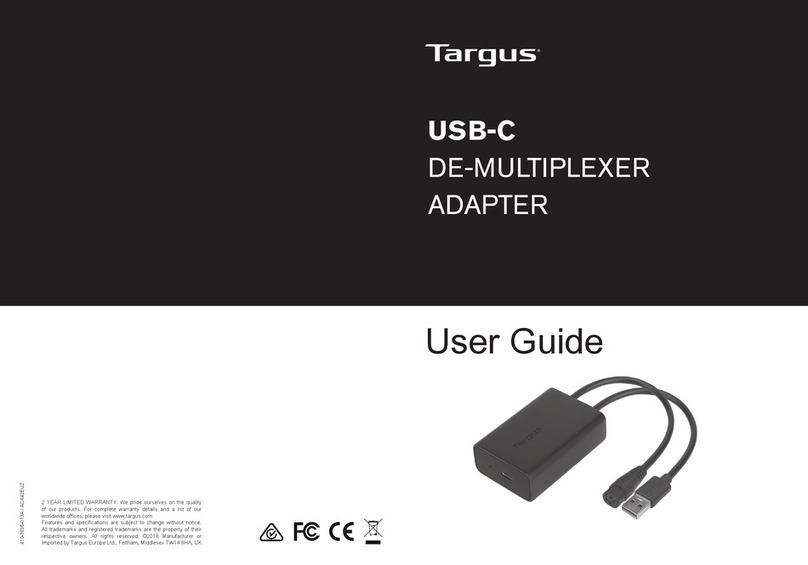Nlynx Gemini Express User manual

GEMINI EXPRESS MULTIPLEXER
User’s Guide

2
TABLE OF CONTENTS
SAFETY 3
Federal Communications Commission (FCC) Statement 3
Classification of LED Transmitter Device 4
INTRODUCTION 5
UNPACKING 6
ACTIVE PAIR SETUP 7
DESCRIPTION 8
CONFIGURATION 9
MODE DESCRIPTION 10
COLLAPSED RINGS 11
CONNECTIONS 12
INSTALLATION 16
Host side multiplexer installation 16
Device side multiplexer installation. 17
PROBLEM SOLVING 19
The MULTIPLEXER ’s front panel power LED is off! 19
The MULTIPLEXER’s RX LED is off or flashing! 19
The MULTIPLEXER ’s TX LED is off! 19
A device is down or unstable! 19
Devices interfere with each other! 20
Devices cannot operate in Express mode! 20
Flashing Express LEDs! 20
Express LEDs on without data activity! 20
SPECIFICATIONS 21
WARRANTY STATEMENT 23
RETURN MERCHANDISE PROCEDURE 23

3
SAFETY
Note: READ THIS FIRST
1. Do not look into any fiber optic connection or fiber optic cable.
2. Do not connect GEMINI EXPRESS MULTIPLEXER to any type of public
network.
3. Do not connect any outdoor cabling to the GEMINI EXPRESS
MULTIPLEXER without proper lightning protection.
4. Do not use unauthorized power supplies or cables.
5. Do not connect to non-5250 protocol devices.
6. Do not disassemble or modify the power supply and its cables.
7. Disconnect all cables prior to configuration.
8. Devices attached to the UTP network must comply with the voltage and
current limits for Class 2 Power-Limited Signal Circuits as defined by
article 725 of the National Electrical Code and Section 16 of the Canadian
Electrical Code.
9. For your safety, receptacles must be properly wired and grounded.
10. Never attempt to service equipment connected to the data cable network or
the grounded receptacle during an electrical storm. Exposure to lethal
voltages may occur when lightning is present.
The following FCC statement applies to the NLynx GEMINI EXPRESS
MULTIPLEXER.
Federal Communications Commission (FCC) Statement
Note: This equipment has been tested and found to comply with the limits for a
Class A digital device, pursuant to Part 15 of the FCC Rules. These limits are
designed to provide reasonable protection against harmful interference when the
equipment is operated in a commercial environment. This equipment generates,
uses, and can radiate radio frequency energy and, if not installed and used in
accordance with the instruction manual, may cause harmful interference to radio
communications. Operation of this equipment in a residential area is likely to
cause harmful interference, in which the user will be required to correct the
interference at his own expense. Unauthorized changes or modifications could
void the user’s authority to operate the equipment.
This device complies with Part 15 of the FCC Rules. Operation is subject to the
following two conditions: (1) this device may not cause harmful interference,
and (2) this device must accept any interference received, including interference
that may cause undesired operation.

4
Classification of LED Transmitter Device Important:
The optical transmitter contains an LED system and is classified “CLASS 1
LED PRODUCT” per EN60825-1 (+A11), Safety of Laser Products. Contact
NLynx Technologies for repair if your GEMINI EXPRESS MULTIPLEXER
ever requires maintenance.

5
INTRODUCTION
This user's manual presents the GEMINI EXPRESS MULTIPLEXER for use
with the IBM 5250 protocol. The 5250 family of products consists of the IBM's
System 34, 36, 38, and the AS/400 along with many supporting devices
manufactured by IBM and other companies. The GEMINI EXPRESS
MULTIPLEXER works with all supporting devices that are designed within the
5250 specifications.
GEMINI EXPRESS MULTIPLEXER
Decision Data’s MULTIPLEXER Gemini Eight-Port Express Fiber Optic
Multiplexer offers the unique ability to allow multiple AS/400 controller polling
groups to be transmitted over a single fiber optic pair. This feature allows all
new AS/400e controllers to provide their maximum throughput potential, in
either 1Mbps Optimized or 2Mbps Express mode, by transparently multiplexing
the "split-polling" feature without requiring performance robbing PTF's. All
new IBM controllers support the "split-polling" feature as a means of achieving
higher throughput rates, even when connected to standard legacy devices. The
Gemini Express Multiplexer allows the "split-polling" feature to remain
"enabled" with performance of up to 4 times greater than standard legacy 1Mbps
5250 protocol. The Gemini Express Multiplexer has 8 Shielded RJ45 port
connections as well as a DB25 "direct-connection" eliminating the need for the
twinax "brick" and associated twinaxial cabling. Link connectivity is via ST
fiber optic multi-mode connection with ability to operate in both point-to-point
and multi-point "ring" topologies, reducing hardware requirements by up to
50%. Other features include Advanced Noise Filtering, LED Port Diagnostics,
Configurable UTP Pin Assignments, and a Field Replaceable wide-ranging
Power Supply.

6
UNPACKING
Remove the packing material and check for the items below:
GEMINI EXPRESS MULTIPLEXER
A (100-240 VAC) input external power supply is attached on the rear panel.
USER'S MANUAL AC POWER CORD
(North American units only)
Visually inspect all items for damage. If any component is damaged, contact
NLynx Technologies for a replacement.
DO NOT APPLY POWER TO ANY DAMAGED COMPONENT!
Gemini Multiplexe
r
Users Guide
NLyn
x

7
ACTIVE PAIR SETUP
All GEMINI EXPRESS MULTIPLEXERS can be factory configured per
customer request. The factory default setting is Pins 4 & 5. Different
configurations will be indicated on the label on the bottom of the unit.
IDENTIFICATION LABEL
The active pair may be re-configured by performing the following procedure:
• Disconnect all power to the unit.
• Remove the two top cover screws located on the rear panel.
• Gently slide the top cover back one inch.
• Hold the top cover and tilt it up.
Reconfigure the jumpers located behind the RJ45 connectors as required.
Settings for polarity and active pair assignment are shown below:
ACTIVE PAIR JUMPER SETTINGS
It should be noted that connections to the DB25 and the RJ45s are mutually
exclusive. If any of the three pairs of the RJ45 are selected, the DB25 is
disconnected. If the DB25 is selected, the RJ45s are disconnected. All jumper
settings must be identical. To reinstall the top cover, tilt the top cover down, and
slide the top cover forward until it mates completely with the bottom cover.
Install the 2 top cover screws.
RJ45 RJ45 RJ45
RJ45 (4/5) RJ45 (3/6) RJ45 (1/2)
RJ45
DB25

8
DESCRIPTION
The GEMINI EXPRESS MULTIPLEXER’s indicators and connections are
described below.
Power LED Amber LED activates when the GEMINI EXPRESS
MULTIPLEXER is powered up.
TX Activity LED Green LED activates when a signal is transmitted to the fiber
optic aggregate link.
RX Activity LED Green LED activates when a signal is received from the fiber
optic aggregate link and the MULTIPLEXER synchronizes to it.
Polling Group Status LEDs The upper green LEDs are express mode
indicators. These LEDs activate when an express signal is detected and remain
on until a 1MBPS signal is detected or a system reset occurs. The lower green
LEDs are data activity indicators. These LEDs activate when a signal is present.
Polling Group Connectors There are two polling groups. Each polling group
has been divided into two port groups. Polling group #1 consists of ports 0 - 3
(port groups A & B) and Polling group #2 consists of ports 4 - 7 (port groups C
& D). Ports within a polling group must be connected to ports from a common
controller.
PRODUCT
DC POWER
CONNECTION
I
DENTIFICATION
LABEL FCC LABEL
EXTERNAL POWER SUPPLY
REAR VIEW
DB25
CONFIGURATION
SWITCHES
FIBER
OPTIC
LINK
Power
LED Fiber
Status
LEDs
Polling
Group 1
Polling
Group 2

9
CONFIGURATION
The configuration switch settings are shown below.
1 2
ON
HOST SIDE MULTIPLEXER POINT TO POINT MODE
CONFIGURATION SWITCHES
SWITCH 1: ON
SWITCH 2: ON
LEGEND
1 2
ON
HOST SIDE MULTIPLEXER
RING MODE
CONFIGURATION SWITCHES
SWITCH 1: ON
SWITCH 2: OFF
LEGEND
1 2
ON
DEVICE SIDE
MULTIPLEXER
POINT TO POINT MODE
CONFIGURATION SWITCHES
SWITCH 1: OFF
SWITCH 2: ON
LEGEND
1 2
ON
DEVICE SIDE
MULTIPLEXER RING MODE
CONFIGURATION SWITCHES
SWITCH 1: OFF
SWITCH 2: OFF
LEGEND

10
MODE DESCRIPTION
A “POINT TO POINT” link is comprised of two Multiplexer s connected by a
single backbone. A diagram of a “POINT TO POINT” link is provided below.
Multiple Multiplexers which are connected in series with fiber optic transmit to
fiber optic receive constitute a “RING” topology. A diagram of a
“RING”application is provided below.
FIBER OPTIC BACKBONE
FIBER OPTIC BACKBONE
MULTIPLEXER
MULTIPLEXER MULTIPLEXER
MULTIPLEXER
HOST PORT
HOST PORT
CONNECTIONS
CONNECTIONS
DEVICE
DEVICE
CONNECTIONS
CONNECTIONS
DEVICE
DEVICE
CONNECTIONS
CONNECTIONS
DEVICE
DEVICE
CONNECTIONS
CONNECTIONS
TX
TX
TX
TX RX
RX
RX
RX
FIBER OPTIC BACKBONE
FIBER OPTIC BACKBONE
MULTIPLEXER
MULTIPLEXER MULTIPLEXER
MULTIPLEXER
HOST PORT
HOST PORT
CONNECTIONS
CONNECTIONS
DEVICE
DEVICE
CONNECTIONS
CONNECTIONS
TX
RX
RX
TX

11
COLLAPSED RINGS
The Ring mode is seldom implemented as depicted in the previous section.
Typically, fiber optic cables star out from a central location. Therefore, a ring is
created by interconnecting the fiber optic star segments at the central location.
This technique is known as a collapsed ring.
COLLAPSED RING
FIBER OPTIC
PATCH PANEL
HOST MULTIPLEX ER
REMOTE MULTIPLEX ER # 1
REMOTE MULTIPLEXER # 2
REMOTE MULTIPLEXER # 3
JU M P ER S
IDF
IDF
IDF
FIBER
OPTIC
MDF
TX RX
TX RX
TX RX
TX RX

12
CONNECTIONS
Typical AS/400 Installation
AS/400 Twinax Brick Details
GXM
AS/400
PATCH
PANEL
STARS
62
.
5
m
i
cron mu
lti
mo
d
e
UTP cablin
g
WALL
PLATE
Balun & T cable
8 Port Twinax Brick
ASF Baluns. See
below for detail.
GXM
0
1
2
3
7
6
5
4
PORT & POLLING GROUP ASSIGNMENTS
ON THE TWINAX BRICK FOR THE NEW AS/400 WSC
WITH SPLIT POLLING FEATURE
ASF BALUN
ASF BALUN
ASF BALUN
ASF BALUN
ASF BALUN
ASF BALUN
ASF BALUN
ASF BALUN
TO AS/400 WSC
TO GXM
PORT# 0
PORT# 1
PORT# 2
PORT# 3
TO GXM
PORT# 4
PORT# 5
PORT# 6
PORT# 7
POLLING GROUP# 1 POLLING GROUP# 2
FRONT VIEW

13
GXM GXM
AS/400
PATCH
PANEL
STAR
62.5 micron multimode
UTP cablin
g
WALL
PLATE
Balun & T cable
DB25 to DB25
STP CABLE
Typical AS/400 Direct Connect Installation
A major difference between the newer AS/400 work station controllers (WSC)
and the older WSCs is the number of polling groups. The older WSCs had one
polling group for all eight ports. The newer WSCs have two polling groups.
Divide the TWINAX brick in two. Ports 0-3 comprise one polling group and
ports 4-7 make up the other polling group. The TWINAX Brick Detail
illustrates a proper connection.

14
Typical Remote Controller Installation
GXM8
PATCH
PANEL
STARS
UTP cabling
WALL
PLATE
Balun & T cable
Two 4 Port Twinax
Bricks & ASF Baluns
Remote
Controller
GXM8 GXM8
62.5 micron multimode fiber

15
Typical System 3X Installation
GXM8 GXM8
SYSTEM 3X
PATCH
PANEL
STAR
62.5 micron multimode fiber
UTP cabling
WALL
PLATE
Balun & T cable
Up to 8 Twinax Ports
& ASF Baluns

16
INSTALLATION
Host side Multiplexer installation.
1. Set the configuration switches on the rear panel of the host side
GEMINI EXPRESS MULTIPLEXER as follows:
SWITCH 1 ON SWITCH 2 ON for a point to point application
or
SWITCH 1 ON SWITCH 2 OFF for a ring application.
2. The GEMINI EXPRESS MULTIPLEXER is designed for a 19”
rack. The unit should be properly installed using all four mounting
holes. Rack hardware is not provided. It is recommended that
plastic or nylon washers be used under mounting screws to protect
the chassis’s finish.
3. A polling group is a group of ports which have one port active at a
time. The new AS/400 work station controllers (WSC) have two
polling groups. Ports 0-3 and ports 4-7 constitute the two groups.
The GEMINI EXPRESS MULTIPLEXER can accommodate two
polling in the same fashion. The GEMINI EXPRESS
MULTIPLEXER polling group #1 consists of ports 0-3 and
GEMINI EXPRESS MULTIPLEXER polling group #2 consists of
ports 4-7. Do not connect more than one host polling group to a
GEMINI EXPRESS MULTIPLEXER polling group. Connect the
host ports to the GEMINI EXPRESS MULTIPLEXER ports.
WARNING DO NOT LOOK INTO ANY FIBER OPTIC
CONNECTOR OR FIBER OPTIC CABLE!
4. The GEMINI EXPRESS MULTIPLEXER has ST style fiber optic
connectors. Connect the multimode fiber optic cables to the optical
link connectors located on the rear panel of the MULTIPLEXER.
Note the fiber color or number on the “TX’ & “RX” to ensure
proper connection at the remote multiplexer location. Strain
relieve and label all cables.
5. The external power supply is mounted on the rear panel of the
GEMINI EXPRESS MULTIPLEXER. The AC power cord must
be firmly inserted into the external power supply and strained
relieved.

17
6. Insert the male end of the AC power cord into a properly wired
receptacle. All data & mode LED’s on the GEMINI EXPRESS
MULTIPLEXER will activate for two seconds and fade off. The
amber power LED on the front panel, the green power led on the
top of the external power supply, and the TX LED will activate and
remain on. At this time the data activity LEDs will flash at the
host’s polling rate. The RX LED will be off until the remote
Multiplexer is installed.
Device side Multiplexer installation.
1. Set the configuration switches on the rear panel of the device side
GEMINI EXPRESS MULTIPLEXER as follows:
SWITCH 1 OFFSWITCH 2 ON for a point to point application
or
SWITCH 1 OFFSWITCH 2 OFF for a ring application.
2. The MULTIPLEXER is designed for a 19” rack. The unit should
be properly installed using all four mounting holes. Rack hardware
is not provided. It is recommended that plastic or nylon washers be
used under mounting screws to protect the star’s finish.
WARNING DO NOT LOOK INTO ANY FIBER OPTIC
CONNECTOR OR FIBER OPTIC CABLE!
3. The GEMINI EXPRESS MULTIPLEXER has ST style fiber optic
connectors. For point to point applications, connect the multimode
fiber optic cable attached to the host side Multiplexer ’s ”TX” to
the device side multiplexer ’s ”RX” optical link connector located
on the rear panel of the GEMINI EXPRESS MULTIPLEXER , and
connect the multimode fiber optic cable attached to the host side
Multiplexer ’s ”RX” to the device side Multiplexer ’s ”TX” optical
link connector located on the rear panel of the GEMINI EXPRESS
MULTIPLEXER. For ring applications, connect the fiber optic TX
of a Multiplexer to the fiber optic RX of the next multiplexer down
stream in the ring until the ring is complete. Ensure that the cables
are properly strained relieved and labeled.
4. Connect the GEMINI EXPRESS MULTIPLEXER ports to the host
ports of the GEMINI active or passive star and follow the
installation procedure for the star.

18
5. The external power supply is mounted on the rear panel of the
GEMINI EXPRESS MULTIPLEXER. The AC power cord must
be firmly inserted into the external power supply and strained
relieved.
6. Insert the male end of the AC power cord into a properly wired
receptacle. All data & mode LED’s on the GEMINI EXPRESS
MULTIPLEXER will activate for two seconds and fade off. The
amber power LED on the front panel, the green power LED on the
top of the external power supply, and the “TX & RX” LEDs will
activate and remain on. If any terminals are on, the data activity
LEDs will activate. If express devices and an express host, are
attached, the port status LEDs (upper green LEDs) will activate.
Devices in a ring application will not show a sign on screen until
the ring is complete.

19
PROBLEM SOLVING
If problems are encountered with the GEMINI EXPRESS MULTIPLEXER, the
following guideline is intended to provide a quick resolution.
1. Collect all information relevant to this application.
• GEMINI EXPRESS MULTIPLEXER serial numbers
• Host type and operating system software level.
• Quantity, and type of peripheral devices.
• Interconnecting cable types and distances.
• Equipment environment.
• Interconnection diagrams.
2. Setup the application with all Multiplexers in one room interconnected with
fiber optic jumpers. Verify the application with a host port and a terminal.
3. Search through the common problems and possible causes provided below.
The GEMINI EXPRESS MULTIPLEXER front panel power LED is off!
• Verify that the AC & DC connections are proper.
• Verify that the AC outlet is functioning correctly.
If the problem persists, observe the status of the external power supply’s LED
and contact Decision Data’s technical support.
The GEMINI EXPRESS MULTIPLEXER RX LED is off or flashing!
• Verify that the fiber optic connectors are properly connected.
• Verify that the fiber optic budget and distance has not been exceeded.
The GEMINI EXPRESS MULTIPLEXER TX LED is off!
• Contact DECISION DATA technical support.
If problems persists, Contact DECISION DATA technical support.
A device is down or unstable!
• Verify that there is one host polling group per GEMINI EXPRESS
MULTIPLEXER polling group.
• Verify that the host’s device type matches the device.
• Verify that the host work station controller’s (WSC) capacity has not
been exceeded.
• Verify that the device is properly terminated. A peripheral is
terminated when its twiaxial port has two 54.9 ohm resistors located

20
between the “A” phase pin & earth ground and the “B” phase pin &
earth ground. Termination is provided by a “Y” or “T” cable assembly
or by a terminating balun (i.e. ASFT series).
• Verify that there are no polarity reversals in the cable.
• Verify that the cable distance does not exceed the GEMINI EXPRESS
MULTIPLEXER specification.
• Verify that the cable is data grade.
• Verify that the wiring uses natural pairs.
• Verify that the wiring avoids sources of environmental noise.
• Verify that the balun’s pinout matches the GEMINI EXPRESS
MULTIPLEXER ’s pinout.
• Verify that the host side balun’s pinout/polarity match the device side
balun’s pinout/polarity.
Devices interfere with each other!
• Verify that there is one host-polling group per GEMINI EXPRESS
MULTIPLEXER polling group.
• Verify that devices on star segments have unique addresses.
• Verify that all devices are properly terminated.
Devices cannot operate in Express mode!
• Verify that the host and the device are capable of Express mode.
• Verify that all interconnecting components support the Express mode.
• Verify that all devices on the port are Express ready.
• Verify that all cable distances are within the Express specification.
• The controller may have down shifted to 1MBPS due to errors during
installation. The controller will retry the Express mode in
approximately one hour.
Flashing Express LEDs!
• Determine the number of Express devices on the port. If there are less
than seven devices, the flashing Express LED is normal.
Express LED on without data activity!
• If the host is disconnected during an express connection, the express
LED remains on.
Other manuals for Gemini Express
1
Table of contents
Other Nlynx Multiplexer manuals
Popular Multiplexer manuals by other brands

Paradyne
Paradyne Hotwire 8799 installation instructions

Gamry Instruments
Gamry Instruments IMX8 quick start guide
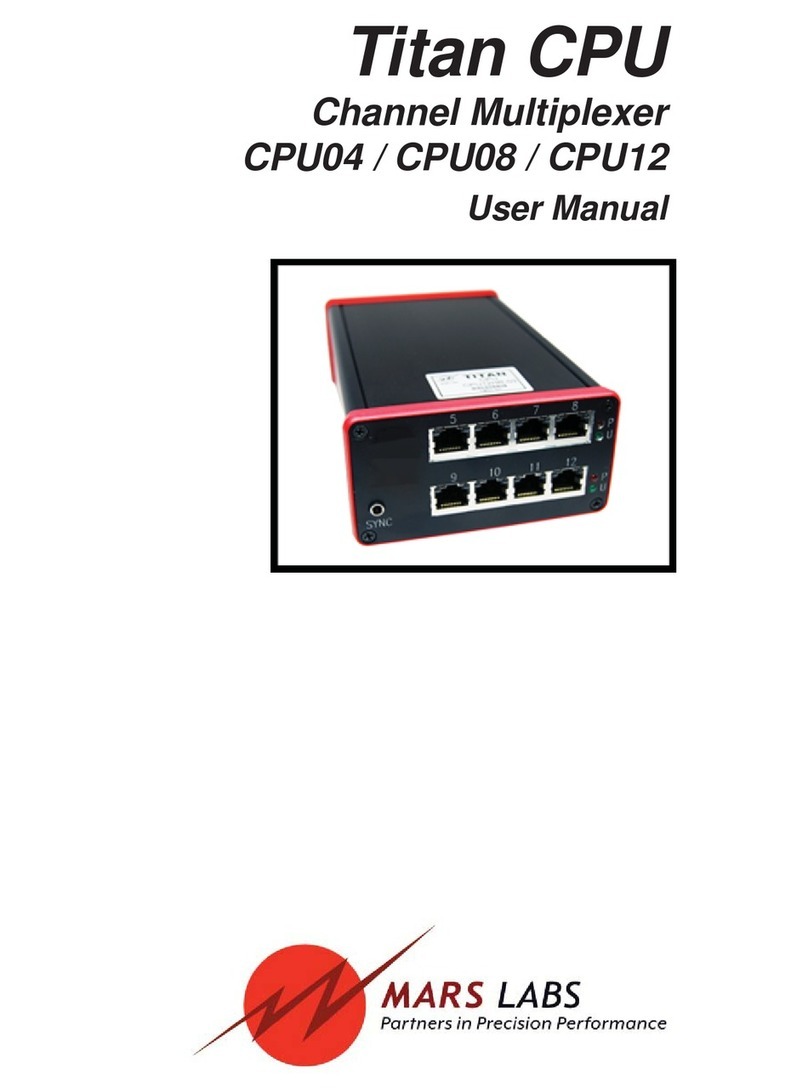
Mars
Mars Titan CPU user manual

Pickering
Pickering 40-611A user manual

Audio international
Audio international VSS-401-x Installation and operation manual
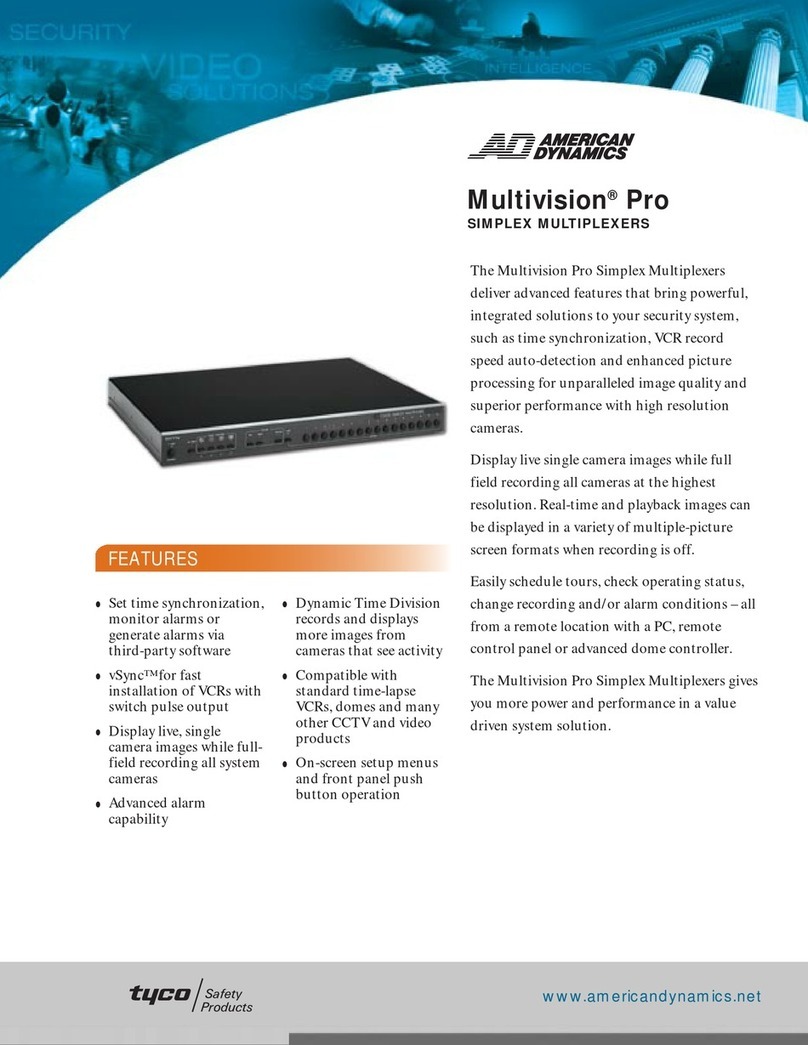
American Dynamics
American Dynamics Multivision Pro SMV104p-30 Specifications
